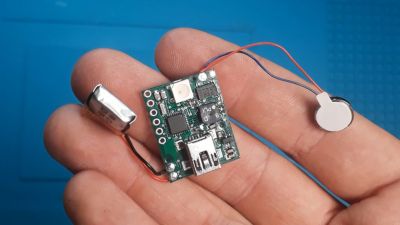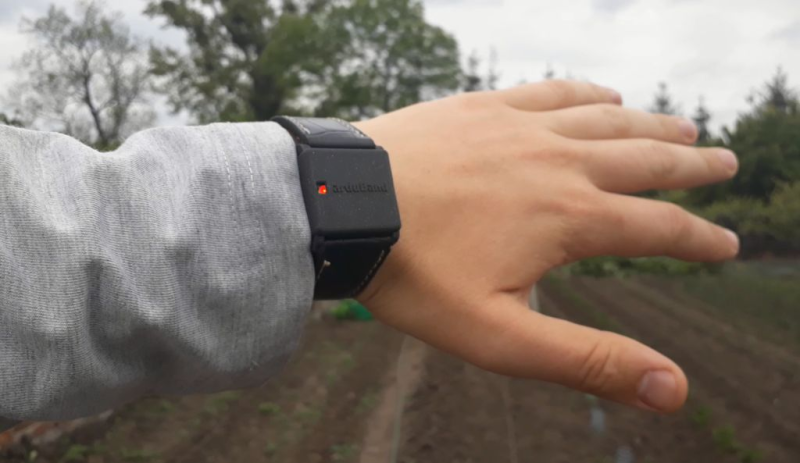Let’s face it, we probably all sit at our computers for way too long without getting up. Yes, there’s work to be done, games to be played, and the internet abounds with people who are wrong and must be down-voted and/or corrected. We totally get and respect all that. However, if you want to maintain your middle- and long-range vision, you should really get up regularly and gaze out the window for a bit.
 In fact, the Arduband does you one better. Its Arduino Nano and accelerometer check your position every ten minutes. If you haven’t changed your Z by the third check, then it’s time for a break. The combination of an RGB LED, buzzer, and vibrating disc motor working together should be enough to pull you out of any computerized stupor, and they won’t give up and go back to sleep until you have stood up and remained upright for one minute.
In fact, the Arduband does you one better. Its Arduino Nano and accelerometer check your position every ten minutes. If you haven’t changed your Z by the third check, then it’s time for a break. The combination of an RGB LED, buzzer, and vibrating disc motor working together should be enough to pull you out of any computerized stupor, and they won’t give up and go back to sleep until you have stood up and remained upright for one minute.
We like that [ardutronics123] spun up a board and made it small enough to be wrist-mounted using a watch strap. It would work just as well worn around your neck, and would probably even fit in your pocket. Blink a few times before you check out the build video after the break.
Arduband would be great on the go, but who does that anymore? If you spend every day at the same desk, you could point a time-of-flight sensor at your chair and start a timer.
















Should use bluetooth to shut off your screen.
Nah. I like how networking doesn’t even come into the equation.
Well then maybe it should just squirt some pepper spray into your eyes, although that’s sort of a Scylla and Charybdis situation.
Hm. Whether I sit or stand, my wrist is at the same height as the table. How would the module detect that I’ve stood up, unless I deliberately hold my hand up for a minute? How would an accelerometer detect absolute displacement anyways?
If it works by sensing hand orientation, then a simpler tilt switch would do. A cone and a metal ball that detects when your wrist is pointing down, and an attiny85 to count up and down depending on the state of the switch. The whole thing could be made considerably simpler.
I don’t think it is accurate to say that tilt switch is simpler than a solid state accelerometer. Especially if you’re still reading the value in software.
You could keep all the same external parts and switch to a much smaller uC, maybe an ATtiny24A or something. You’d have to add a multiplexer or something to get all the same functionality onto an ATtiny85.
But an ATmega328 isn’t exactly big or expensive. Maybe an update is going to have some more features?
OR you could sit on a nail, after a while it gets so painful you need to get up and walk about. If SIMPLE is the only design concern.
Nice idea. My fitbit has something similar — but it detects steps and if there haven’t been so many in the time interval, then it prods you into motion. Maybe this could be modified to have a step detection/counting algorithm via the accelerometer. That would fix Luke’s complaint.
I have a list of complaints about the fitbit, but in this regard the bug in their code is that it deletes the option to do the above every time you charge it, so you more or less have to reconfigure the device after every charge.
There’s an even simpler solution to detecting whether you’re sitting or standing. A thin piece of foam rubber with foils on both sides, slip in your back pocket, measure the capacitance to find out whether the person is sitting or standing.
Yep, but that misses the point that just standing up is not the optimal thing, it is getting a bit of motion going and some blood pumping.
how about a needle is slowly coming out of your chair, i can guarantee you will stand up :)
It would also be nice to have a taser option.
And maybe a low voltage AC signal so if you don’t stand up, it activates your lower body muscles anyways. You can exercise in place if you’re in a hurry.
How easy would it be to turn off the alarm by just raising your hand for a minute?
What would be the point of wearing it if you’re going to cheat?
But, it detects your hand pointing up instead of down, which shouldn’t count anyhow since you might be scratching your beard or drinking tea when the check is made.
Can do the same using a webcam machine vision AI Woo Woo magic!